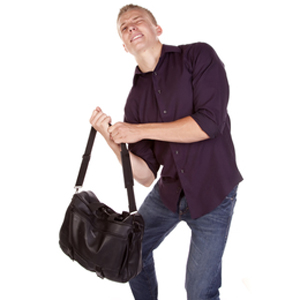 Carrying around pounds of possessions in a heavy bag can lead to disabling back pain. Here’s how to choose the best bag for your back — and wear it the right way — to avoid pain.
Carrying around pounds of possessions in a heavy bag can lead to disabling back pain. Here’s how to choose the best bag for your back — and wear it the right way — to avoid pain.
In today’s society, many people are carrying around more and more things around in backpacks, briefcases, computer bags, and purses. The result — back pain.
It’s an epidemic! In fact, low back pain causes more global disability than any other condition.
When talking about bags as a potential cause of back pain, you should empty your bags. And you’ll observe pounds and pounds of stuff — several water bottles, three or four books, sets of keys you thought were lost, $20 in coins.
People are also carrying much more technology than ever before, from smartphones to laptops. They seem like little things, but they all add weight.
Strategies for a Back Pain-Friendly Bag
The next time you head out the door with a bag, try these ideas to lighten your load and spare your back:
• Pick the smallest bag you can. The bigger the bag, the more you put in it. Do yourself a favor and carry the smallest bag filled with only what you really need and leave the rest at home. Keep in mind that it’s usually not one single item that leads to back pain symptoms. More likely, it’s the accumulation of smaller items, such as loads of loose change, that causes pain.
• Aim for symmetry. Putting extra weight on one side of your body is one of the biggest back pain causes. Any time you carry weight on one side of your body for an extended period of time, it causes your spine to curve, and that leads to back pain symptoms. With that in mind, it’s better to choose a messenger bag that you wear diagonally across your body rather than a single-strap bag that rests on one shoulder.
• Switch sides. When you can’t avoid using a single-strap bag, be conscious of changing the sides you use to carry it. If it’s a short strap that you carry with your hand, regularly move it from your left hand to your right hand. If it’s a shoulder strap, try changing it from your left shoulder to your right shoulder.
• Go for thick straps. A thin strap resting on your shoulder can cut into your muscles and lead to problems.
• Wear a backpack. Backpacks aren’t just for school kids anymore. The dual straps of a backpack are the best at evenly distributing weight on your body, and that’s leading more adults to use them. Frequent fliers are turning to carrying backpacks as a remedy for back pain. After packing up books, a laptop, a work organizer, and more, a bag weighs at least 20 pounds when you head for the airport, and carrying everything in a briefcase with a strap leads to lower pain. Keep in mind that the way you wear a backpack is key because it can change your gait. When you slide a backpack onto your shoulders, adjust the straps so that you carry it as high on your back as you can. The top of the backpack should be at the same level of the big bone you feel at the lowest part of your neck. Also, keep the straps tight so the bag is as close to your body as possible. Wearing it close means it will feel lighter.
• Pull a bag on wheels. Airline pilots and flight attendants used to carry single-strap bags and developed their own unique musculoskeletal problems. But today you see them using pull-cart bags or luggage on wheels, which helps them avoid back pain symptoms.
• Designate different bags for different uses. Rather than trying to carry everything in one bag, designate a briefcase for business, a gym bag for exercise clothes, another bag for your kids’ items, and so on.
• Aim to carry less than 10 percent of your body weight. Ideally, you shouldn’t carry around more than 10 percent of your body weight, so put your bag on a scale and see how it measures up. If it’s too heavy, see if there’s anything you can do without.
The best thing you can do for your back is to be a minimalist. Don’t carry what you don’t have to, but when you need to take a bag with you, choose the right one and wear it the proper way to eliminate back pain causes.



Leave A Comment
You must be logged in to post a comment.